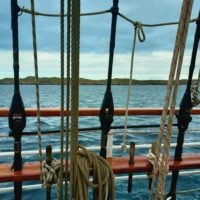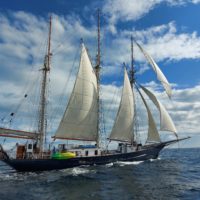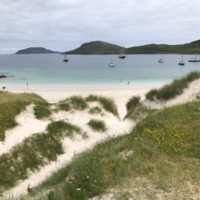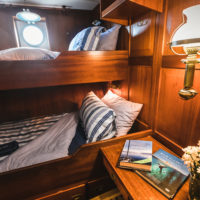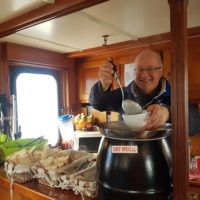BC270724 Outer Hebrides and St Kilda £2345
UK and Scotland

Mallaig, Scotland - Oban, Scotland
Explore the rugged scenery and hidden gems of the Inner and Outer Hebrides on our tall ship Blue Clipper.
From our base in Mallaig some of the places we hope to visit are and St Kilda (weather dependant) Vatersay and the Isle of Mull..
To enquire about this voyage please click the ‘BOOK NOW’ button below and you will be re-directed to our booking agent VentureSail Holidays where you can make an enquiry. VentureSail manage all our holiday voyages and the team at the office are available on 01872 487288 if you have any questions.
| Ship | Per Person Twin En-Suite |
|---|---|
| Blue Clipper | £2,345.00 |
| Embarkation | Disembarkation | Nights |
|---|---|---|
| July 27, 2024 | August 3, 2024 | 7 |
BC270724 Outer Hebrides and St Kilda
27th July 2024 - 3rd August 2024
Voyage Highlights
- The opportunity to visit St Kilda (weather dependant)
- Unspoilt skies around Coll and Tiree
- Amazing beaches on Vatersay and Barra
Life on a sailing voyage
On a sailing voyage we never use the word itinerary, as skippers will always be aiming for the best sailing and shore landings for the forecast and most idyllic or sheltered anchors and ports. They are as keen as you to include some of the highlights describe, but you have to go with Mother Nature, not fight her. The description below is based on what we think might be possible, based on past trips, or experience, but nothing is guaranteed on a sailing voyage. If the following voyage description is not fulfilled for any reason, Maybe Sailing and Maybe Sailing Youth Initiative cannot be held responsible.
VOYAGE DESCRIPTION
Join Blue Clipper and her crew from Mallaig to Oban as she explores the Inner and outer Hebrides from April to August 2024.
Some of the places we may visit:
VATERSAY AND BARRA
Sitting at the southern end of the Island chain of the Outer Hebrides, Barra and Vatersay offer an exciting mix of contrasting island experiences with something on offer for every. Feel the strong sense of community created by crofters and seafarers who live side by side on these isolated islands.
View the Barra seals at Seal Bay for a stunning snapshot of the islands natural heritage or stroll amongst the wildflowers on the Vatersay machair to truly understand the allure of Outer Hebridean isolation.
ISLE OF HARRIS
The outer Hebridean island of Harris is one that has offered inspiration for generations. With its rich traditions, stunning shifting scenery and strong sense of community. Harris offers a unique introduction to island life on the edge. Visit the village of Tarbert, home to the Harris Tweed Shop and the recently opened Isle of Harris Distillery.
Gaze out across the West Harris sands to the famous uninhabited Castaway island of Taransay and experience a glimpse of the isolation from which the proud self-sufficent communities of the Outer Hebrides were born, or tour the adjoining Isle of Scalpay with its strong seafaring connections to understand more about the symbiosis of islanders and ocean.
ISLE OF LEWIS
The largest of the Outer Hebrides, Lewis offers amazing opportunities to explore all the elements life on the edge in the Atlantic Ocean – with history, heritage, wilderness, wildlife, arts and crafts.
See the ancient Callanish Standing Stones rising from the Lewis landscape to give an imposing outline against the endless island skies and hear the echoes of the past murmuring round these monoliths – an eternal testament to islanders enduring spirit and ingenuity.
Explore the sea caves and stacks at Garry Beach to better understand how the relentless seas have shaped the island environment and the lifestyles of those who live here.
ST KILDA
With a suitable weather window, we aim to visit the Island archipelago of St Kilda, lying 41 miles off the west coast of Benbecula. St Kilda is an extreme Atlantic outpost, and one of the few World Heritage sites in existence awarded ‘dual’ status for meeting both the natural and cultural criteria for the classification.
With its clear waters and craggy sea cliffs (including one that ranks as Europe’s highest) it is not surprising that St Kilda is home to the continent’s largest colony of seabirds including gannets and puffins. The islands also support a number of unique species of sheep, field-mice and wrens, making it a fascinating natural island environment unmatched anywhere on earth.
Originally settled by humans between four and five thousand years ago, St Kilda’s distance from the rest of the Outer Hebrides allowed for the development of a unique style of self-sufficient island life, that remained much preserved until the archipelago’s eventual abandonment in 1930.
Investigation of the history of St Kilda helps us to understand a little more about the evolution of island communities and the challenges they face from both society and the elements.
Now owned by the National Trust and classified as a National Nature Reserve by Scottish National Heritage, St Kilda is managed in partnership with the Ministry of Defence who lease land here for an important radar tracking station.
Island explorers can choose from a selection of walks offering ample opportunities for wildlife watching, while the more intrepid may venture into the island’s crystal clear waters – recognised as one of Europe’s most spectacular dive sites, as well as being home to whales and basking shark, which can sometimes be spotted from the shore.
Tour the old village, where St Kilda’s indigenous Soay sheep wander and graze among the blackhouse ruins of a bygone island age, or visit the museum house on the main village street, where artefacts from that era are exhibited.
Find the faerie house – an underground store that could date from as early as 500BC, or climb to the top of Mullach Mor to gain a greater understanding of the settlements positioning against the Atlantic elements.
After visiting St Kilda in the decades after its abandonment, naturalist James Fisher wrote that the islands would “haunt” those who saw them for “the rest of their lives” – adding that it was “impossible to accurately describe” these awe inspiring islands – meaning you will just have to visit and see this stunning sea-bound spectacle for yourself!
What is included in the voyage cost:
- All meals on board Blue Clipper – including daily breakfast, lunch and evening meal
- Refreshments throughout the day
- Use of safety equipment
- Accommodation in a twin en suite cabin
- All instruction and lectures on board by fully qualified crew
What is not included:
- Travel to and from the boat
- Personal travel insurance. Check out Top Sail for specialist Tall Ship sailing travel insurance
- Alcoholic and soft drinks
- Any shore excursions and meals on shore (unless otherwise stated)
- VISA fees
Mallaig, Scotland
Oban, Scotland
Embark Travel Information
Mallaig, Scotland
Getting Here
The most convenient way to travel to Mallaig is by train, taking the train from Glasgow, via Fort William. This is a spectacular train journey, one of the best in the country.
Perhaps the most impressive moment in the journey to Fort William is just north of Tyndrum station, where the railway describes a horseshoe curve beneath the immense Fujiyama-like shape of Ben Doran while crossing two curved viaducts, the scale of the landscape making one feel very insignificant.
On the Mallaig line the highlight is undoubtedly the northbound climb to Glenfinnan station across the famous viaduct, set in an amphitheatre of mountains and overlooking the Glenfinnan Monument, erected in 1815 to mark the spot where Bonnie Prince Charlie raised his standard in 1745.
The journey time between Glasgow Queen Street and Fort William is about 3¾ hours, between Fort William and Mallaig just under 1½ hours.
You could choose to fly into Glasgow before you embark on the train journey to Mallaig or take the time-saving and still romantic way to reach the Highlands on the Caledonian Sleeper from London, alias the Deerstalker; the moment of raising the blind in the morning to the sight of mountains when the previous view was the bowels of Euston station is an uplifting contrast. It is also miraculous and heartening that some of the most desolate platforms in the world can still be connected to a capital city by sleeper train.
Prices
Advance fares for Glasgow–Mallaig start at £15.70 each way, so the cheapest return is £31.40. The Jacobite adult day return fare is £33, child £19 in standard class, £56 and £31 in 1st class. Prices on the Caledonian Sleeper start at £19 for a single journey.
Disembark Travel Information
Oban, Scotland
By Road
- Car – If you are travelling by car you can check out the AA or RAC websites and plan your route.
- Coach – If you are travelling by coach you can visit the Citylink website or phone them on 08705 505050
By Rail
If you come by train, the journey takes you along the world-famous West Highland Line. First ScotRail runs trains six times a day from Glasgow Queen Street Station to Oban (two on Sunday). For times and prices visit the First Scotrail site. You can also phone National Rail enquiries on 08457 484950 or visit their website, and they have a good app for smart phones.
By Air
Flying to Glasgow or Edinburgh is easy. Both airports are served by all the major, and many of the minor, UK airlines. This provides plenty of flights to choose from with bargain rates. In addition to being busy domestic airports both Glasgow and Edinburgh receive daily scheduled flights from Europe. Glasgow also boasts direct flights to and from the United States and from Dubai.You can also fly to Oban directly by private charter flight to Oban Airport at North Connel.
- Glasgow is the nearest large airport to Oban and is approximately 90 miles away. There are good links from the airport to the train and bus terminals in the city.
- Prestwick Airport
- Edinburgh Airport
- Oban Airport
By Sea
Oban is a busy ferry port with regular ferries to and from the islands of Mull, Colonsay, Coll, Tiree, Lismore, Barra and South Uist. Many of these ferries also link up with other islands. For more information about the ferries you can visit the Calmac website.





